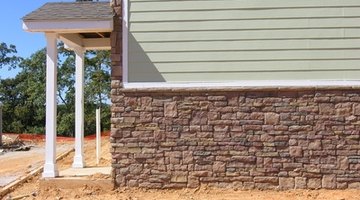How to Overlap Vinyl Siding
Vinyl siding is water-resistant if installed properly. To prevent excess water from accumulating behind the vinyl siding, the top panels should overlap the bottom panels to allow natural run-off of rain. Likewise, side seams should overlap in a staggered formation. While this does not allow a completely waterproof seam, it does minimize seepage enough for the moisture barrier to do the rest.

-
Measure the bottom span of the house and cut the aluminum starter strip with a reverse-direction saw blade attached to a circular saw to the appropriate size.
-
Measure the height of the starter strip and subtract 1 to 3 inches to allow for overhang. Measure up from the top of the foundation with respect to that measurement. Run a chalk line laterally and make sure it is level. Snap the chalk line to leave a pronounced line across the bottom of the house, which will be your guide for installing the starter strip.
-
Align the starter strip with the chalk line and nail in place at 12-inch intervals in the center of the nailing slots.
-
Measure the span width for the area you will be applying the vinyl siding. Cut the vinyl siding to the appropriate width, if required, with the reverse-direction blade. If the span is wider than the piece of vinyl siding, you will add another piece to cover the remainder.
-
Slide the interlocking bottom of the vinyl siding over the starter strip. Although the locking mechanism almost mandates the position of the vinyl siding, it is always a good idea to measure and snap a level chalk line, since there is a little flexibility there, and this will insure a level installation. Nail the siding in place using 1 5/8-inch nails at 10-inch intervals, but be careful not to drive the nail tight against the vinyl siding, since this can cause buckling or distortion. Always drive the nails straight and level and leave no more than 1/32 inch from the nail head to the top edge of the vinyl siding.
-
Measure and cut your next piece of vinyl siding to cover the remaining width of the span. Align the siding and interlock the bottom, as done previously. Make sure to overlap the first piece by at least 1 to 3 inches to create a rain barrier.
-
Measure and cut the next higher section. You will want to stagger the side seams, so even if the span is longer than the vinyl siding, you will need to cut to keep the seams from forming a line straight up the side of the house. An easy way to do this is to cut the vinyl siding the width of the second piece you just installed. That way the remainder will simply be the full length of a section of vinyl siding.
-
Align, interlock and nail this next piece just as you did before, and continue the procedure until the entire house is complete. At the tops, corners and around windows and doors, you will cut and attach trip pieces, which will overlap the vinyl siding sections to create a better, more aesthetic seal. These should be nailed at 8-inch intervals.
References
Writer Bio
C. Taylor embarked on a professional writing career in 2009 and frequently writes about technology, science, business, finance, martial arts and the great outdoors. He writes for both online and offline publications, including the Journal of Asian Martial Arts, Samsung, Radio Shack, Motley Fool, Chron, Synonym and more. He received a Master of Science degree in wildlife biology from Clemson University and a Bachelor of Arts in biological sciences at College of Charleston. He also holds minors in statistics, physics and visual arts.
Photo Credits
- stone and siding image by jimcox40 from Fotolia.com
More Articles



